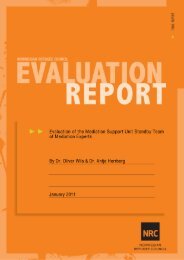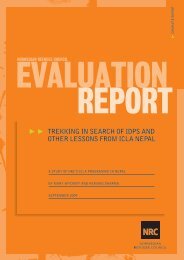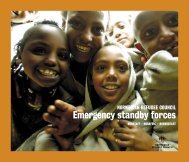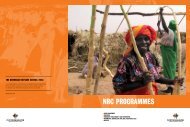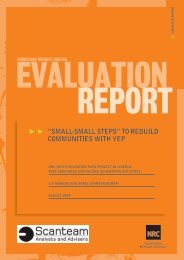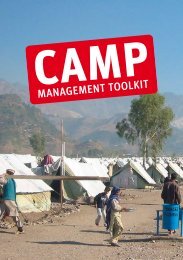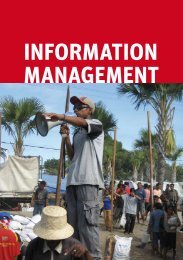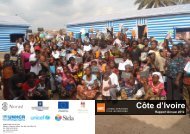evaluation of general food distribution in northern uganda: gulu ...
evaluation of general food distribution in northern uganda: gulu ...
evaluation of general food distribution in northern uganda: gulu ...
Create successful ePaper yourself
Turn your PDF publications into a flip-book with our unique Google optimized e-Paper software.
From the 2007 EFSA 104 it transpired that adults <strong>in</strong> 52% <strong>of</strong> the households had only one meala day and the figure was higher <strong>in</strong> transit sites (60%) 105 Even for children the figures werenoticeable, with 36% report<strong>in</strong>g only 1 meal and 3% report<strong>in</strong>g no meals the previous daybefore the EFSA survey. 47% could manage to feed their children twice a day, but only 14%were <strong>in</strong> a position to give their children more than 3 meals a day. The EFSA does <strong>in</strong>dicatethat Gulu, Amuru and Kitgum seem to be far<strong>in</strong>g better than the rema<strong>in</strong><strong>in</strong>g sample sites forthe EFSA 2007. Although not commonly adopted, some <strong>of</strong> the more disturb<strong>in</strong>g anddamag<strong>in</strong>g cop<strong>in</strong>g strategies that the Evaluation Team discovered through some focus groupdiscussions with IDPs were:Box 10: Other cop<strong>in</strong>g strategies 2005 -2008 106♦♦♦♦♦♦Begg<strong>in</strong>g or send<strong>in</strong>g your younger family members to begTheft (crime rates <strong>in</strong> camps are <strong>in</strong> <strong>general</strong> high)Prostitution (also by young mothers)Child labour by send<strong>in</strong>g children <strong>of</strong> young age to workGambl<strong>in</strong>gExploit<strong>in</strong>g natural resources for sell<strong>in</strong>g (charcoal burn<strong>in</strong>g)The Evaluation Team found that despite hav<strong>in</strong>g more access to land and hav<strong>in</strong>g left behi ndthe stra<strong>in</strong>s <strong>of</strong> camp-life, the cop<strong>in</strong>g strategies <strong>in</strong> transit sites <strong>in</strong> Gulu and Kitgum 107 seemmore challeng<strong>in</strong>g than <strong>in</strong> the mother camps. The lack <strong>of</strong> basic services such as health,access roads, clean water and sanitation <strong>in</strong> particular puts people <strong>in</strong> a vulne rable situation.The Evaluation Team’s observations show (and were confirmed by several NRC staff andvolunteers) that the malnutrition levels amongst lactat<strong>in</strong>g mothers and the vast number <strong>of</strong>children who have not yet reached the school go<strong>in</strong>g age was relat ively high. As mentionedearlier nutritional surveys conducted by WFP concentrate their research ma<strong>in</strong>ly <strong>in</strong> mothercamps 108 .In spite <strong>of</strong> these observations, several <strong>in</strong>terviews and f<strong>in</strong>d<strong>in</strong>gs documented <strong>in</strong> monitor<strong>in</strong>greports from amongst others NRC, the common understand<strong>in</strong>g that IDPs are not meet<strong>in</strong>gtheir net <strong>food</strong> gap is still disputed. For example district <strong>of</strong>ficials <strong>in</strong> Gulu emphasised to theEvaluation Team that as documented <strong>in</strong> the Nutrition Surveys, Northern Uganda is “out <strong>of</strong> thedanger zone…. people today are okay… and…they produce enough to supply the Sudanmarket”. 109 If there are reasons for the Acholi people not meet<strong>in</strong>g their net <strong>food</strong> gap, it isaccord<strong>in</strong>g to some <strong>of</strong>ficials because they ‘by nature are lazy’ 110 and that <strong>food</strong> aid over thepast 10 years has brought about a highly <strong>in</strong>convenient ‘dependency syndrome’ 111 .One UN agency was strongly <strong>of</strong> another view: “IDPs do not want the <strong>food</strong> rations any longerand they can grow the <strong>food</strong>. The problem is only that the yield is not high enough andtherefore they are not meet<strong>in</strong>g their net <strong>food</strong> gap…they need tractors…If they had the option,they would go for someth<strong>in</strong>g else than <strong>food</strong> aid. The option is still not there. Food is no longerconsidered a push or a pull factor…” 112 .104 The EFSA 2007 covers mother camps and transit camps <strong>in</strong>: Gulu, Kitgum, Pader, Apac & Oyam, Amuria & Katakwi andLira – i.e. figures <strong>in</strong>clude Acholi, Lango and Teso regions.105 EFSA 2007, p.12106IDPs <strong>in</strong>terviewed for the Evaluation are not representative <strong>of</strong> the entire IDP population, and as stated these cop<strong>in</strong>g strategiesare not commonly adopted amongst all IDPs <strong>in</strong>terviewed. Some answers are also confirmed <strong>in</strong> NRCs own monitor<strong>in</strong>g reportsfrom 2005-2008.107 Pawidi <strong>in</strong> Kitgum, Lukwor <strong>in</strong> Kitgum and Oraphoyo <strong>in</strong> Gulu108WFP Nutritional Surveys <strong>of</strong> 2006 and 2007 conducted <strong>in</strong> 53 mother camps <strong>in</strong> Gulu109 Interview with DDMC, Gulu.110 District Official, Gulu111 District Official Gulu112Interview with UNHCR Gulu.35





